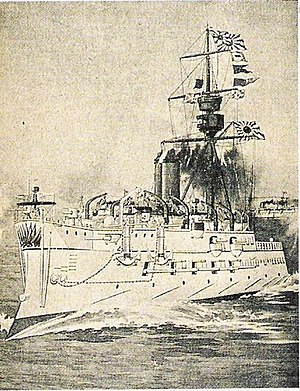Japanese cruiser Matsushima

Matsushima, flagship of the Japanese Navy in the Sino-Japanese War.
|
|
| History | |
|---|---|
|
|
|
| Name: | Matsushima |
| Ordered: | 1886 Fiscal Year |
| Builder: | Société Nouvelle des Forges et Chantiers de la Méditerranée, La Seyne-sur-Mer, France |
| Laid down: | 17 February 1888 |
| Launched: | 22 January 1890 |
| Completed: | 5 April 1892 |
| Struck: | 31 July 1908 |
| Fate: | Sunk after accidental explosion 30 April 1908 |
| General characteristics | |
| Class and type: | Matsushima-class cruiser |
| Displacement: | 4,217 long tons (4,285 t) |
| Length: | 91.81 m (301 ft 3 in) w/l |
| Beam: | 15.6 m (51 ft 2 in) |
| Draft: | 6.05 m (19 ft 10 in) |
| Propulsion: | 2-shaft reciprocating; 6 boilers; 5,400 hp (4,000 kW), 680 tons coal |
| Speed: | 16.5 knots (19.0 mph; 30.6 km/h) |
| Complement: | 360 |
| Armament: |
|
| Armor: |
|
Matsushima (松島?) was a Matsushima-class protected cruiser of the Imperial Japanese Navy. Like her sister ships, (the Itsukushima and Hashidate) her name comes from one of the traditional Three Views of Japan, in this case, the Matsushima archipelago near Sendai in Miyagi prefecture.
Forming the backbone of the Imperial Japanese Navy during the First Sino-Japanese War, the Matsushima-class cruisers were based on the principles of Jeune École, as promoted by French military advisor and naval architect Louis-Émile Bertin. The Japanese government did not have the resources or budget to build a battleship navy to counter the various foreign powers active in Asia; instead, Japan adopted the radical theory of using smaller, faster warships, with light armor and small caliber long-range guns, coupled with a massive single 320 mm (12.6 in) Canet gun. The design eventually proved impractical, as the recoil from the huge cannon was too much for a vessel of such small displacement, and its reloading time was impractically long; however, the Matsushima-class cruisers served their purpose well against the poorly equipped and poorly led Imperial Chinese Beiyang Fleet.
...
Wikipedia
